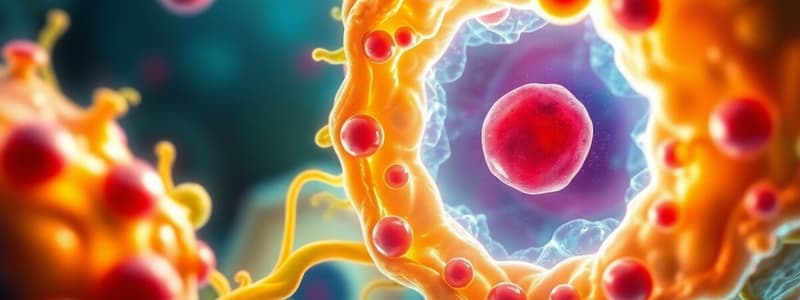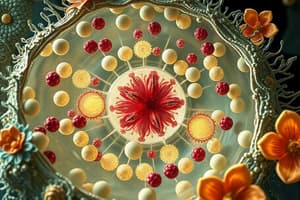Podcast
Questions and Answers
Which of the following statements about cell structure is NOT correct?
Which of the following statements about cell structure is NOT correct?
- Plant cells have chloroplasts, whereas animal cells do not.
- Lysosomes function in the digestion of cellular waste products.
- Plant cells have cell walls, whereas animal cells do not.
- Ribosomes are the main sites of energy production for the cell. (correct)
What would happen to a human red blood cell if it was placed in distilled water?
What would happen to a human red blood cell if it was placed in distilled water?
- It would shrivel.
- It would not be affected.
- It would lyse. (correct)
- It would plasmolyse.
Which of the following pairs does NOT represent a correct relationship?
Which of the following pairs does NOT represent a correct relationship?
- starch; carbohydrate
- fat; lipid
- starch; polysaccharide
- enzyme; lipid (correct)
Which of the following statements is correct?
Which of the following statements is correct?
Which of the following statements about meiosis is correct?
Which of the following statements about meiosis is correct?
An animal organism with a diploid number of chromosomes equal to 30 would normally?
An animal organism with a diploid number of chromosomes equal to 30 would normally?
Which of the following is true about enzymes?
Which of the following is true about enzymes?
The Calvin cycle of photosynthesis takes place here?
The Calvin cycle of photosynthesis takes place here?
What was the dependent variable in the experiment to determine the effect of using Fretwork on plant growth?
What was the dependent variable in the experiment to determine the effect of using Fretwork on plant growth?
Which element acts as a hydrogen acceptor during aerobic respiration?
Which element acts as a hydrogen acceptor during aerobic respiration?
Which of the following tissues contains the highest number of mitochondria?
Which of the following tissues contains the highest number of mitochondria?
What is the site where glycolysis takes place?
What is the site where glycolysis takes place?
Which of the following statements describes a fundamental characteristic of all living organisms?
Which of the following statements describes a fundamental characteristic of all living organisms?
Which of the following describes the difference between cilia and flagella?
Which of the following describes the difference between cilia and flagella?
Which compound is released in a dehydration reaction?
Which compound is released in a dehydration reaction?
Which of the following is true regarding the similarities between the fins of a shark and the fins of a dolphin?
Which of the following is true regarding the similarities between the fins of a shark and the fins of a dolphin?
What happens when an N atom changes to N+?
What happens when an N atom changes to N+?
Which of the following is an example of an enzyme cofactor?
Which of the following is an example of an enzyme cofactor?
Which property allows the interaction between water molecules in the xylem vessels of plants, contributing to their movement up these vessels?
Which property allows the interaction between water molecules in the xylem vessels of plants, contributing to their movement up these vessels?
Which of the following is considered as an exocrine and an endocrine gland?
Which of the following is considered as an exocrine and an endocrine gland?
Which statement accurately describes the products formed during transcription?
Which statement accurately describes the products formed during transcription?
What is the expected outcome when an organism with a diploid chromosome number of 30 undergoes meiosis?
What is the expected outcome when an organism with a diploid chromosome number of 30 undergoes meiosis?
Which element plays a crucial role as the final electron acceptor in the process of aerobic respiration?
Which element plays a crucial role as the final electron acceptor in the process of aerobic respiration?
In the context of plant growth experiments, which part of the experiment is the independent variable?
In the context of plant growth experiments, which part of the experiment is the independent variable?
Which of the following accurately represents the sequence of human circulation?
Which of the following accurately represents the sequence of human circulation?
What is the role of flagella in cells?
What is the role of flagella in cells?
Which statement accurately describes the outcome of Griffith's experiment?
Which statement accurately describes the outcome of Griffith's experiment?
What happens to an atom when it changes from N to N+?
What happens to an atom when it changes from N to N+?
Which of the following processes is classified as semi-conservative?
Which of the following processes is classified as semi-conservative?
Which compound is primarily released during a dehydration reaction?
Which compound is primarily released during a dehydration reaction?
Flashcards are hidden until you start studying
Study Notes
Cell Structure and Function
- Plant vs. Animal Cells: Plant cells have cell walls and chloroplasts; animal cells lack these structures.
- Ribosomes: Ribosomes are not energy producers; they synthesize proteins.
- Lysosomes: Function in digestion and waste processing within cells.
Cellular Environment
- Red Blood Cells in Distilled Water: Human red blood cells will lyse (burst) when exposed to distilled water due to osmotic pressure.
Genetics and Meiosis
- Independent Assortment: Genes on nonhomologous chromosomes assort independently.
- Meiosis Outcome: Meiosis creates gametes with half the chromosome number; e.g., from a diploid number of 30, produces four gametes with 15 chromosomes each.
Enzymes and Metabolism
- Enzyme Characteristics: Enzymes are not consumed in reactions, often require cofactors, and are comprised of amino acids.
- Glycolysis Location: Glycolysis occurs in the cytoplasm of the cell.
Photosynthesis
- Calvin Cycle: Takes place in the stroma of chloroplasts and is essential for converting carbon dioxide into glucose.
- Fruit Ripening Hormone: Ethylene is the plant hormone responsible for fruit ripening.
Cellular Transport and Interaction
- Water Molecule Interaction: Cohesion helps with water movement through xylem vessels in plants.
- Dehydration Reaction Product: Water (H2O) is released during dehydration synthesis reactions.
Tissue and Organ Systems
- Muscle Types: Cardiac muscle is involuntary; striated skeletal muscle is voluntary.
- Epithelial Cells: Cover body surfaces and line cavities, playing vital roles in protection and secretion.
Bacteria vs. Viruses
- Structural Differences: Bacteria have a cellular structure with a membrane, while viruses are acellular and lack organelles.
Cellular Respiration
- Aerobic Respiration Equation: The overall reaction is C6H12O6 + O2 → CO2 + H2O + 36 ATP.
- Hydrogen Acceptor: Oxygen acts as a hydrogen acceptor during aerobic respiration.
Evolution and Genetics
- Biological Evolution Definition: Refers to changes in inherited traits in populations over generations.
- Transformation in Bacteria: Griffith's experiment demonstrated the transformation process, revealing that bacteria can exchange genetic material.
Miscellaneous Facts
- Cilia vs. Flagella: Cilia are shorter and more numerous than flagella.
- Apoptosis Functionality: Involves lysosomes and serves as programmed cell death for maintaining health.
- Peptide Bonds: Form between amino acids during protein synthesis.
Immune System
- Types of White Blood Cells: Phagocytes and lymphocytes are essential for immune responses, aiding in the identification and destruction of pathogens.
Cell Structure and Function
- Plant vs. Animal Cells: Plant cells have cell walls and chloroplasts; animal cells lack these structures.
- Ribosomes: Ribosomes are not energy producers; they synthesize proteins.
- Lysosomes: Function in digestion and waste processing within cells.
Cellular Environment
- Red Blood Cells in Distilled Water: Human red blood cells will lyse (burst) when exposed to distilled water due to osmotic pressure.
Genetics and Meiosis
- Independent Assortment: Genes on nonhomologous chromosomes assort independently.
- Meiosis Outcome: Meiosis creates gametes with half the chromosome number; e.g., from a diploid number of 30, produces four gametes with 15 chromosomes each.
Enzymes and Metabolism
- Enzyme Characteristics: Enzymes are not consumed in reactions, often require cofactors, and are comprised of amino acids.
- Glycolysis Location: Glycolysis occurs in the cytoplasm of the cell.
Photosynthesis
- Calvin Cycle: Takes place in the stroma of chloroplasts and is essential for converting carbon dioxide into glucose.
- Fruit Ripening Hormone: Ethylene is the plant hormone responsible for fruit ripening.
Cellular Transport and Interaction
- Water Molecule Interaction: Cohesion helps with water movement through xylem vessels in plants.
- Dehydration Reaction Product: Water (H2O) is released during dehydration synthesis reactions.
Tissue and Organ Systems
- Muscle Types: Cardiac muscle is involuntary; striated skeletal muscle is voluntary.
- Epithelial Cells: Cover body surfaces and line cavities, playing vital roles in protection and secretion.
Bacteria vs. Viruses
- Structural Differences: Bacteria have a cellular structure with a membrane, while viruses are acellular and lack organelles.
Cellular Respiration
- Aerobic Respiration Equation: The overall reaction is C6H12O6 + O2 → CO2 + H2O + 36 ATP.
- Hydrogen Acceptor: Oxygen acts as a hydrogen acceptor during aerobic respiration.
Evolution and Genetics
- Biological Evolution Definition: Refers to changes in inherited traits in populations over generations.
- Transformation in Bacteria: Griffith's experiment demonstrated the transformation process, revealing that bacteria can exchange genetic material.
Miscellaneous Facts
- Cilia vs. Flagella: Cilia are shorter and more numerous than flagella.
- Apoptosis Functionality: Involves lysosomes and serves as programmed cell death for maintaining health.
- Peptide Bonds: Form between amino acids during protein synthesis.
Immune System
- Types of White Blood Cells: Phagocytes and lymphocytes are essential for immune responses, aiding in the identification and destruction of pathogens.
Studying That Suits You
Use AI to generate personalized quizzes and flashcards to suit your learning preferences.




